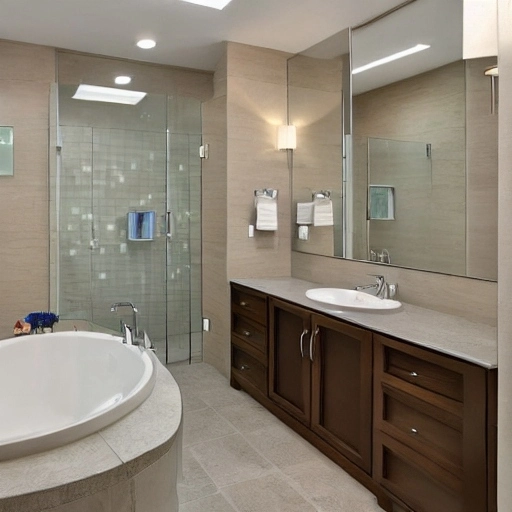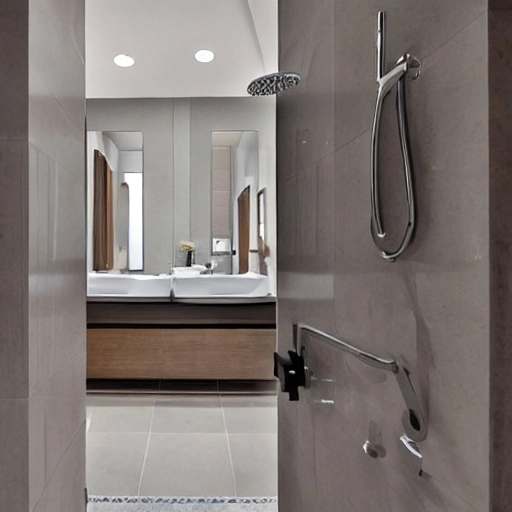If you’re planning a bathroom renovation, there are a few things you need to take into account to ensure the project runs smoothly.
In this blog post, we’ll run through some of the key considerations, from budgeting and hiring contractors to choosing materials and designing your space.
In this post, we’ll share some tips on how to plan for your bathroom renovations. We’ll discuss everything from budgeting to choosing the right contractor.
By following these tips, you can make sure your bathroom renovation goes off without a hitch!
1) Planning Your Bathroom Renovation.
Deciding on a Budget
When planning your bathroom renovation, the first step is to decide on a budget.
This will help you determine what type of renovations you can afford, and help you set expectations with your contractor.
To come up with a budget, start by evaluating how much you can afford to spend on the project.
Then, consider the value of your home and what type of return on investment (ROI) you hope to get from the renovations.
Finally, research the cost of materials and labor in your area to get an estimate of what the project will cost.
Once you have a budget in mind, it’s time to start planning your renovation. The first thing you’ll need to do is find a qualified contractor who can do the work within your budget.
To find a good contractor, ask for recommendations from friends or family members who have recently renovated their homes.
You can also search online for customer reviews of local contractors.
Once you’ve found a few potential candidates, be sure to get written estimates so that you can compare prices before making a final decision.
Hiring a Contractor
After you’ve decided on a budget for your bathroom renovation, it’s time to start looking for a qualified contractor who can do the work within that budget.
To find a good contractor, ask for recommendations from friends or family members who have recently renovated their homes.
You can also search online for customer reviews of local contractors.
Once you’ve found a few potential candidates, be sure to get written estimates so that you can compare prices before making a final decision.
When interviewing contractors, be sure to ask about their experience with similar projects.
You’ll also want to get a sense of their design style and whether or not they are willing to work with you to create the bathroom of your dreams.
Once you’ve found a contractor that you’re comfortable with, be sure to get everything in writing before work begins.
This will help prevent any misunderstandings about the scope of work or the cost of the project down the road.
Planning for Unexpected Costs
Be sure to ask your contractor about potential hidden costs that could come up during the course of your project.
These could include anything from issues with the plumbing to problems with the structure of your bathroom.
By being prepared for these unexpected costs, you can avoid any nasty surprises down the road.
Selecting Materials
After you’ve hired a contractor and settled on a budget, it’s time to start selecting materials for your bathroom renovation.
This is where you’ll really get to personalize your space and make it your own.
When choosing materials, consider both function and aesthetics. For example, if you’re planning on doing a lot of cooking in your new kitchen, then durability and easy-to-clean surfaces should be a top priority.
On the other hand, if you’re more concerned with creating a stylish space, then you may want to focus on materials that add visual interest, such as stone countertops or glass tile backsplashes.
You’ll also need to decide on finishes for your fixtures and hardware. These days, there are endless options available, from brushed nickel faucets to marble countertops.
Take some time to browse online or in home improvement stores to get an idea of what’s available and what fits within your budget.
Once you’ve made all of your selections, be sure to get everything in writing from your contractor so that there are no surprises when work begins.
Also Read – 11 Tips for Planning a Successful Bathroom Renovation
2) Creating a Design Plan.

Defining the Scope of the Project
The first step in creating a design plan is to define the scope of the project. This means deciding what work needs to be done, how much it will cost, and who will be doing it.
Once you have a clear idea of the project’s scope, you can begin to create a plan.
Selecting Your Fixtures and Finishes
One of the most important aspects of any bathroom renovation is choosing the right fixtures and finishes.
These items will set the tone for your space and determine its overall look and feel.
When selecting fixtures and finishes, it’s important to consider both function and aesthetics.
Make sure that the products you select are durable and easy to clean, but also take into account your personal style preferences.
Creating a Floor Plan
After you’ve selected your fixtures and finishes, it’s time to start planning your floor plan.
This is where you’ll decide on the layout of your space and where each element will go.
When creating a floor plan, it’s important to keep both function and aesthetic in mind.
You’ll want to create a space that is both practical and visually appealing.
3) Demolition and Prep Work.
Preparing Your Space
Before any demolition or construction can begin, it’s important to prepare your space.
This means clearing out all personal items, removing any fixtures that you don’t want to keep, and covering up floors and surfaces that could be damaged during the renovation process.
You should also take measures to protect yourself from dust and debris, such as wearing a dust mask and eye protection.
Demolition Day
Once everything is prepared, it’s time for demolition day!
This is when the bulk of the work will be done to tear out old fixtures and materials.
It’s important to have a plan for this phase of the project so that everything goes smoothly.
For example, you’ll need to decide what order you want things demolished in, how you’re going to dispose of the debris, and whether you’re going to do the work yourself or hire someone to do it for you.
4) Installation.
Plumbing
The first step in any bathroom renovation is to install new plumbing.
This may involve running new water lines, installing a new toilet, or adding a new sink.
If you are working with an experienced contractor, they will be able to handle all of the necessary plumbing for your renovation.
If you are doing the work yourself, it is important to make sure that you follow all local building codes when installing new plumbing.
Failure to do so could result in costly repairs down the line.
Additionally, it is always a good idea to consult with a professional plumber before starting any major plumbing work.
Electrical
After the plumbing has been installed, it is time to wire up the electrical outlets and fixtures.
This is another area where it is important to follow local building codes.
You will also need to obtain the proper permits before beginning any electrical work.
If you are not comfortable working with electricity, it is best to hire a professional electrician to handle this part of the renovation for you.
They will be able to ensure that everything is properly wired and up to code.
Tile Work
One of the most popular choices for bathroom renovations is tile work.
This can include anything from flooring and backsplashes to shower surrounds and tub decks.
Tile work can be tricky, so it is important to consult with a professional before starting your project.
They will be able to help you select the right type of tile for your space and give you tips on how to properly install it.
Once the tile work is complete, your bathroom will have a completely new look and feel!
Also Read – 5 Easy Ways to Remove Old Wallpaper
5) Finishing Touches.

Painting
Once the major installation work is complete, it’s time to focus on the finishing touches.
One of the most important things to consider is painting. You’ll want to choose a color scheme that complements the materials and fixtures you’ve selected.
If you’re not sure where to start, consult a professional designer or take inspiration from your favorite hotel bathroom or spa.
Hardware
Another important element to consider is hardware.
This includes things like towel bars, toilet paper holders, towel rings, soap dishes, and robe hooks.
Again, it’s important to choose pieces that complement the overall design of your bathroom.
For example, if you have chosen a more traditional style, then oil-rubbed bronze or brass hardware would be a good option.
If your bathroom has a more modern look, then stainless steel or glass might be better choices.
Accessories
The final touch is accessories. This can include anything from rugs and towels to artwork and plants.
Again, think about what will complement the overall design of your bathroom and make it feel like a relaxing oasis.
A few well-chosen accessories can make all the difference in how your bathroom looks and feels!
6) Managing the Project.
Scheduling the Work
The first step in managing your bathroom renovation project is to create a schedule.
This schedule should include not only when each task will be completed, but also who will be responsible for completing it.
For example, if you are hiring a contractor to do the work, you will need to coordinate their schedule with the schedules of any tradespeople they will be working with, such as plumbers and electricians.
If you are doing the work yourself, you will need to plan your own time so that you can complete the tasks in a reasonable order.
In either case, it is important to leave some flexibility in your schedule in case there are delays or unforeseen problems.
It is also important to have a realistic understanding of how long each task will take so that you can plan accordingly.
Coordinating with tradespeople
If you are hiring a contractor to do the work, they will be responsible for coordinating with any tradespeople who are needed for the job.
However, if you are doing the work yourself, it will be up to you to coordinate with these tradespeople.
This includes scheduling their time so that they can come and do their work while other tasks are being completed, as well as communicating with them about what needs to be done and how it should be done.
For example, if you are having new plumbing installed, you will need to communicate with the plumber about where the pipes need to go and what type of fixtures need to be connected to them.
If you are having electrical work done, you will need to let the electrician know where outlets and light fixtures need to be installed and what type of wiring they will need to use.
By coordinating with these tradespeople ahead of time, you can avoid delays and ensure that the job is done properly.
Dealing with Delays
No matter how well you plan or how experienced your contractor is, there is always a chance that delays will occur during a bathroom renovation project.
This could be due to weather conditions, availability of materials or labor, or simply because something takes longer than expected.
When this happens, it is important to have patience and understand that these things happen from time to time.
The most important thing is that the job gets done right and that everyone stays safe during the process.
Conclusion
After reading this blog post, you should have a good understanding of how to plan for your bathroom renovations.
By following the steps outlined in this post, you can ensure that your project stays on track and within budget.
Keep in mind that even small bathroom renovations can be complex projects, so it is important to be prepared and to work with a reputable contractor.
With careful planning and execution, your bathroom renovation will be a success!


